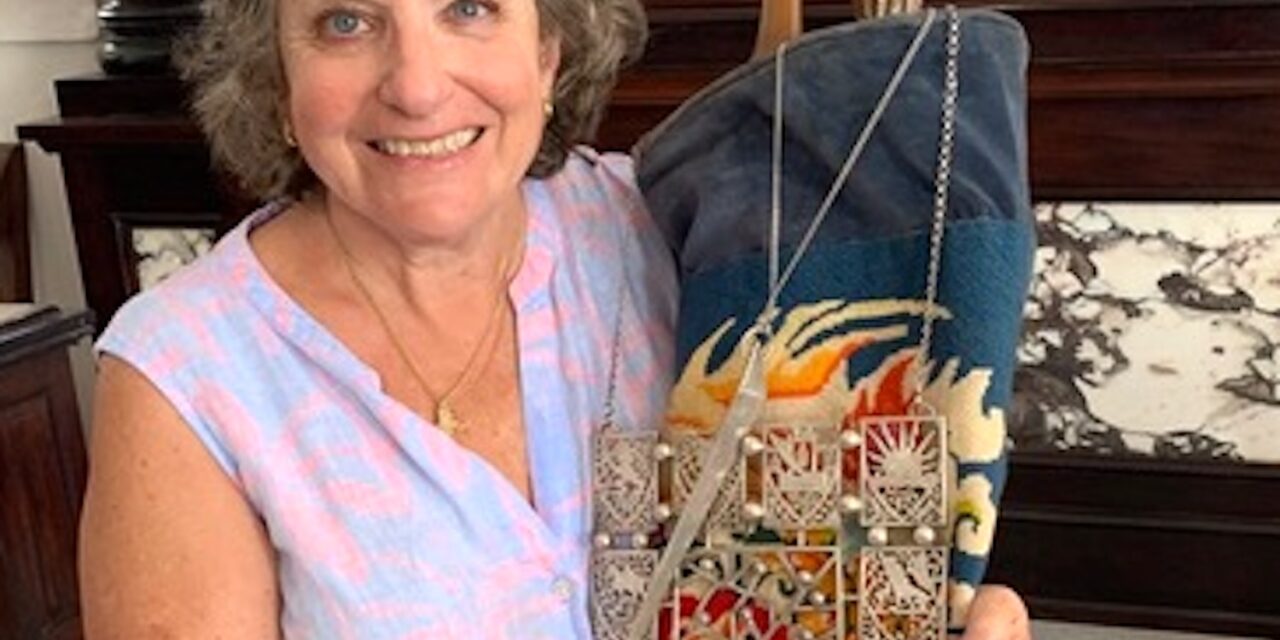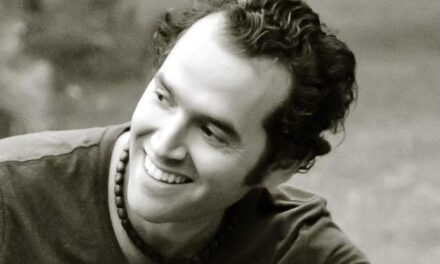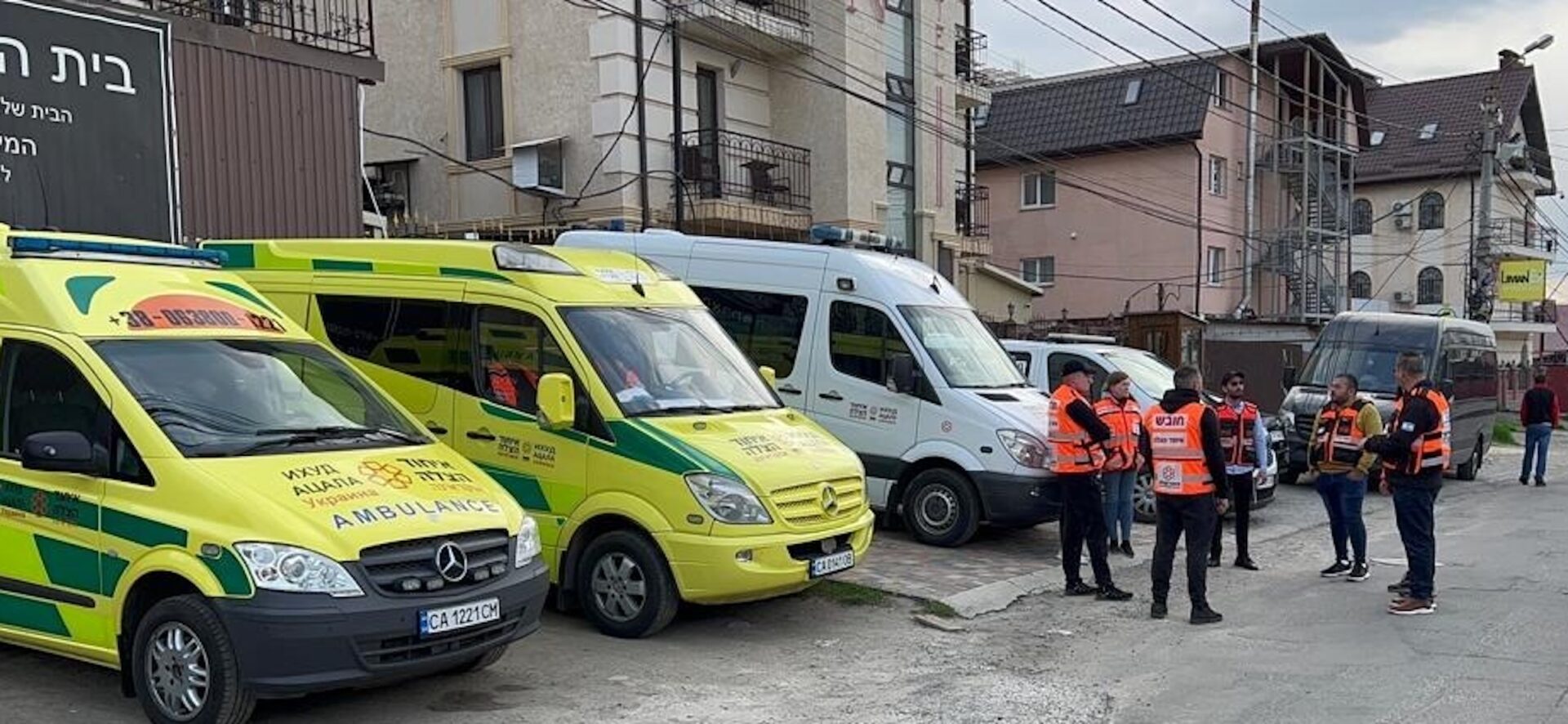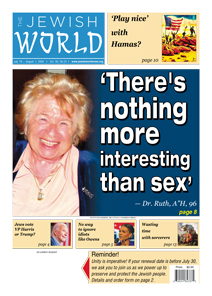By MARILYN SHAPIRO
Under a hot tropical sun, Larry and I wound our way first along the Caribbean Sea and then, a couple of zigzags to the left, up a steep hill. We stood in front of a large stone edifice with its white plaster column and point-arch windows. Robert Kunkel, the docent/educator, opened up the black iron gate and led us up a set of stairs to the large point-arch entrance doors.
After several trips to the Caribbean, Larry and I were finally visiting the Hebrew Congregation of St. Thomas, the second oldest synagogue building in the western hemisphere and the oldest in continuous use under an American flag.
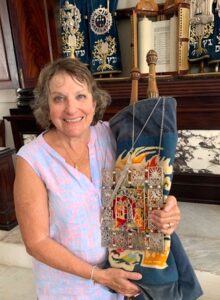
Marilyn Shapiro holds the Memorial Scrolls Trust Torah (MST #533), which was rescued from Budyně nad Ohří, a small town in Bohemia, Czech Republic in front of the ark at the Beracha Veshalom Vegmiluth Hasadim Synagogue in St. Thomas.
The Sands Of Time?
Stepping past the threshold, we immediately noticed a carpet of sand that covered the center of the room. We then took in the beautiful architecture. A domed ceiling, holding the eternal light, soared above us. The mahogany pews, finished by 19th century shipbuilders, were set up in on three sides to face the ark. A striking marble slab supported its base. Above the curtained doors, two tablets representing the Ten Commandments were engraved in the native stone. More pointed-arch windows let in the bright light, while thick white plaster walls helped keep the interior cool.
As we settled into the pews, Kunkel shared his vast knowledge of the synagogue and its role in the history of St. Thomas, the largest of the three main islands that comprise the U.S. Virgin Islands. But first he addressed our most pressing question: Why sand? He explained that the first Jews in the Caribbean were of Sephardic, or Spanish-Portuguese descent. The floor, one of only five like it in the world, is a reminder of how its Jewish ancestors who lived in the two countries’ area during the Spanish Inquisition (most active between 1480 and 1530) were forced to practice their religion in secret in their basements, covering the floors so that their footsteps and voices would be muffled.
How did these Iberian Jews end up in St. Thomas? Facing a choice of forced conversion or expulsion, victims of the Spanish Inquisition fled to European cities. Over the next four centuries, partially as a result of discrimination in other professions, Jews developed a mercantile trade, which led them to countries in both South America and the Caribbean, including St. Thomas. The population of Jews on this island remained small until the years after the American Revolution, when an influx of Sephardic Jews set up businesses in a climate of great tolerance and little discrimination.
Fires Damage Buildings
In 1796, the Jews of St. Thomas founded B’racha V’shalom (Blessing and Peace). The first structure was destroyed in a fire in 1804 that also destroyed several hundreds of building on the island. In 1812, the Jewish community purchased land and built a new synagogue. A growing population resulted in erecting a new expanded wooden structure with an expanded name: “Blessing and Peace and Loving Deeds” Congregation Beracha Veshalom Vegmiluth Hasadim,
On Dec. 31, 1831, another fire destroyed one quarter of the buildings on St. Thomas, including the shul. Not to be deterred, the Jewish community began an international fund-raising effort to raise the $5,000 needed to rebuild a house of worship made of stone, brick, and mortar. The building, including two Torahs and the eternal light that had been rescued from the fire, was consecrated in September 1833 to the joy of the congregation and the surrounding community that had also donated money, materials, and labor. This was the building we were standing in almost 190 years later.
Community Involvement
As the congregation grew, the congregation purchased a burial ground, established a Hebrew school, and began using clergy. As with all congregations, the following years were filled with joy and sorrow, schisms over liturgy and rabbis, contracting and expanding membership. Through it all, it remains a living, vibrant synagogue connected closely to its community. Most notably, two members of the congregation were appointed governors the Virgin Islands: Morris Fidanque De Castro (1950-1954) and Raphael Moses (Ralph) Paiewonsky (1961-1969).
As written in the museum’s online narrative, the St. Thomas Synagogue continues to follow in the footsteps of its ancestors, preserving their heritage and honoring their traditions. Part of this renewal was the congregation’s current search for a rabbi, as its most recent spiritual leader had relocated to New Jersey to be closer to his family.
Sacrifice, Survival, Strength
After the narrative, the tour guide opened up the ark, which housed seven Torahs. The one Sephardic Torah was housed vertically in a beautiful wooden cylindrical case with the following the customs of the Spanish-Portuguese Jewry to both store and read the scrolls while standing in their cases. The six other Ashkenazi Torahs were dressed in the traditional Ashkenazi accessories each with a mantel (velvet covering); Atzei Chayim (wooden shafts) topped with keters (crowns); and a yad (pointer) They rested at an angle on the back of the ark. Because of my interest in the Shoah, my favorite was a Memorial Scrolls Trust Torah (MST #533), which was rescued from Budyně nad Ohří, a small town in Bohemia, Czech Republic. Jews had lived there from the 13th century; its diminished population (known to number 50 people in 1930) was liquidated by the Nazis in 1942.
With the guide’s approval, Larry and I took turns holding the Holocaust Torah before saying goodbye. We spent time in the museum gift shop, where we purchased a mezuzah, Through the Sands of Time: A History of the Jewish Community of St. Thomas, U.S. Virgin Islands by Judah M. Cohen, and a T-shirt for Larry that proclaimed, “I Climbed Synagogue Hill.” We headed back to our cruise ship, thankfully a downhill journey, happy to know that we finally got to see this living museum of Jewish sacrifice, survival, and strength.
New Chapter
The synagogue recently started a new chapter.
In February, less than a week after our visit, the Hebrew Congregation of St. Thomas welcomed Julia Margolis as its first female rabbi. Rabbi Margolis took a long, circuitous route to the shul. Born in Moscow, USSR, her family had moved to Israel when she was 12. After graduating from high school and serving in the Israel Defense Forces, she completed undergraduate degrees in Jewish history, Islam, and art and earned a master’s degree in Jewish studies.
Following in the footsteps of her mother, who was the first Russian speaking female rabbi in Israel, Margolis was ordained by the Abraham Geiger College in Germany. Closely connected to the Reform Movement, Margolis was heading a synagogue in Johannesburg, South Africa when she saw that this congregation was looking for a new rabbi. She submitted her application but was still surprised when she was contacted by the search committee.
In the middle of their negotiations, her husband Greg died. Following her heart, she decided to make the move with her two children to St. Thomas where she reports that she was soon “soaking in the beauty and the spirituality of this place.”
“God always has a plan,” Margolis shared in a March 21, 2023, article in the Virgin Islands Daily News. “It takes a lot of time sometimes to see that, but there is always a plan.”
Synagogue Trivia:
The Mikvé Israel-Emanuel Synagogue in Curaçao is the oldest synagogue building in the Western Hemisphere. (1730)
The Touro Synagogue in Newport, Rhode Island, is the oldest synagogue building in North America that is still standing. (1763)
The Old New Synagogue of Prague in the Czech Republic is the oldest active synagogue in the world. (1270s)
The Ben Ezra Synagogue in Cairo, Egypt is the oldest synagogue in the world and also the longest serving. The original synagogue dates back to the ninth century. When Jews fled Egypt in the 1950s, it was turned into a museum.
Temple Israel in Leadville, Colo., holds the record for the highest synagogue in the world. Founded in 1884, the synagogue sits at an elevation of 10,152 above sea level. It is now a museum.
https://www.chabad.org/library/article_cdo/aid/339596/jewish/The-Accessories-for-the-Torah.htm

